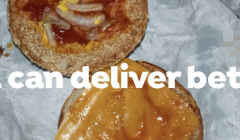
Knorr spotlights fast food fails to deliver better
The campaign from MullenLowe highlights that home made food can be better than takeaways.

Amidst the increasingly wild west of social media, industry leaders address a brand safety tipping point.

In 2017 The Times newspaper ran a front page story on brands funding terror. At the time the story was seen as a watershed for the marketing industry with brand safety at the top of the marketing agenda. The irony is that 8 years later the ethos of ‘brand safety’ has hit news brands hard. With the widespread adoption of blacklists within programmatic advertising platforms hitting the advertising revenues of trusted newsbrands. While Mark Zuckerberg’s recent announcement that Meta will be getting rid of fact-checkers underlining that brands are still operating in a wild west of social media.
Analysts now suggest that half of all global adspend now goes to Google, Meta, Amazon and TikTok. Generative AI affords brands unparalleled opportunity to create a larger number of assets at a lower cost. Personalisation at scale is no longer just an empty marketing buzzword.
Yet at the same time Trust is a brand’s most valuable asset. A truth underlined by Channel 4’s response to Meta’s news; a campaign declaring: ‘We fact check the Zuck out of our news’.
With a lack of visibility of where their advertising appears combined with the inadvertent algorithmic cruelty of defunding trusted journalism, brand safety is at a tipping point. With this in mind we asked industry experts if a lack of transparency in brands’ approach to brand safety is eroding trust in marketing?

The advertising supply chain can be vast, complex, and often opaque—creating risks not just for brand safety but for business growth and corporate responsibility. For this reason, CAN, are working with the UN, to help implement the Global Principles for Information Integrity with a focus on transparency and effectiveness for advertisers.
Without true transparency, CMOs and CFOs cannot make informed decisions about where their media spend goes. They might be unknowingly funding misinformation, climate denial, or hate speech. Transparency has to be the foundation, otherwise responsible media investment is impossible.
We’ve already seen one global advertiser take back control of their supply chain, resulting in lower carbon emissions, increased funding for journalism, double-digit gains in return on ad spend, and higher sales across their brands. This shows transparency isn’t just a moral imperative; it’s a commercial one too.
CAN members are driving this change and demanding better. The industry must follow suit—because otherwise, trust in marketing will continue to erode.

YES!
One of the levers we have to build trust is in selecting how and where we communicate with our audience. The context in which a message is seen has a considerable impact on its effectiveness.
Broadcast media companies are experts at framing their trust claims* but it’s not a leap to conclude that trusted environments lend this virtue to the brands that advertise there. The reverse is also true - a decline in quality and reliability in any environment will tarnish brands showing up in this space.
This goes way beyond media & marketing. The 2025 Edelman Trust Barometer introduces us to a ‘crisis of grievance’. Extreme inequality, hopelessness and a bombardment of dis- and misinformation continue to damage trust in all our institutions, from governments to charities.
In monetizing and perpetuating this crisis, those algorithms have a lot to answer for.

Transparency is not a luxury in marketing, it’s a necessity. To remove it means to erode trust, whether it’s on social media sites or through advertising. Add increasing consumer scepticism to this and you start to create a recipe of diminishing trust - something which becomes a direct threat to brand-building and inevitably damages long-term growth.
This is why enhancing brand lift measurement through independent, trusted partners is more critical than ever. By gaining insights in real-time across all the media mix, we can present much deeper analysis of audience sentiment and how they perceive and respond to certain ads. This gives advertisers more of an opportunity to dictate not just where to place ads for maximum effectiveness but also ensure they are building the trust and transparency needed to drive successful campaigns.
Advertising across a fragmented social landscape feels very much like the Wild West, where brands may face limited visibility into where their ads appear and the impact they deliver. It will require a collective effort across the industry—GAFAM included—to adopt tools that prioritise audience intent and third-party validation. By doing so, advertisers can confidently navigate a brand-safe ecosystem, ensuring that trust is not just maintained but actively reinforced.

Meta's decision to eliminate fact-checkers underscores the mounting challenges of navigating brand safety in an increasingly unmoderated social media landscape. Any compromise to online brand safety standards risks eroding trust—not only in the platforms themselves but also in the brands that rely on them and in the marketing industry as a whole.
This trust is further complicated by a shifting regulatory environment. While reduced moderation may become the norm in the U.S., brands will find it hard to resist the unparalleled scale and reach of platforms like Meta, especially if they continue to deliver strong results. Conversely, the European Union’s potential enforcement of stricter regulations, such as the Digital Services Act (DSA), could drive brands toward more moderated environments, such as Programmatic Open Web platforms, which stand to gain from these regulatory changes.
This growing divergence in moderation standards may compel brands to adapt their strategies accordingly. However, to navigate these shifts effectively, brands must remain vigilant about brand safety and take proactive steps to protect their reputation in an evolving digital landscape.

Meta’s decision to follow X down the dangerous path of favouring “Community Notes” over third-party fact-checking programmes has shown that the platforms do not have the safety of people at the heart of their decision-making.
In the US, these announced changes will risk Instagram, Facebook, and Threads becoming unsafe landscapes filled with dangerous hate speech, violence, harassment, and misinformation, particularly for marginalised communities. In fact, under Meta’s content policy changes, you may now freely refer to women as property or objects, or refer to transgender or non-binary people as “it” or “mentally ill”. This is unacceptable, highly damaging and is setting us back years of progress.
At Social Element, we believe this moment underscores the urgency to Make Social Better. Brands, you are the answer because we cannot rely on the platforms. Your ad spend powers Meta, and it can be used as leverage to make positive change.
It’s time to lead by example. Foster and prioritise ethical engagement to protect your communities and ensure that your content truly aligns with your core values. Protective moderation, transparent partnership and thoughtful content strategies are key to rebuilding trust and ensuring your brand has a positive impact on the world. By prioritising safety, accountability and inclusivity, brands can counteract the erosion of trust and support meaningful online interactions.
The future of marketing belongs to those who reject hate in the guise of freedom of expression and work to build social spaces that can be enjoyed and are safe for all.
Looks like you need to create a Creativebrief account to perform this action.
Create account Sign inLooks like you need to create a Creativebrief account to perform this action.
Create account Sign in